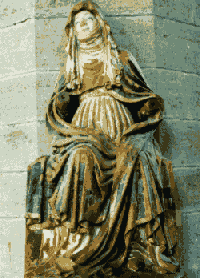Meet the Middle Ages
BackSt. Bridget

St. Birgitta, (Bridget in English) is one of the most famous women of the Nordic Middle Ages. She had great influence on the lives of many people during her lifetime as well as after her death. Birgitta is the only Nordic person who has been canonised by the Pope.
 Birgitta was born in 1303. She belonged to one of the ruling families of the country. Her father was the well-known Chief Judge, Birger Persson. When she was 11 years old, Birgitta ´s mother died and the girl went to live with her aunt. In 1316, when Birgitta was 16, her father decided that she should marry the nobleman Ulf Gudmarsson, who was 18. At the age of 13, Birgitta ran a large household at the manor of Ulvåsa in Östergötland. For many years, she was in charge of all practical matters there. Ulf and Birgitta had eight children - four boys and four girls.
Birgitta was born in 1303. She belonged to one of the ruling families of the country. Her father was the well-known Chief Judge, Birger Persson. When she was 11 years old, Birgitta ´s mother died and the girl went to live with her aunt. In 1316, when Birgitta was 16, her father decided that she should marry the nobleman Ulf Gudmarsson, who was 18. At the age of 13, Birgitta ran a large household at the manor of Ulvåsa in Östergötland. For many years, she was in charge of all practical matters there. Ulf and Birgitta had eight children - four boys and four girls.
Birgitta has described to us how she brought up her children. She might threaten to whip them, but she never did so. She rewarded them with apples or sweets if they were good. At Ulvåsa, Birgitta also took care of and supported women who had been cast out of the community. For some time she left the manor to take up the position as lady-in-waiting at the court of King Magnus and Queen Blanche. Here, her main task was to bring up the princes Erik and Haakon.
Birgitta and Ulf undertook several pilgrimages to foreign countries. They travelled to Trondheim in Norway, to visit the shrine of St. Olav. They also went to Santiago de Compostela in Spain to visit the grave of St. Jacob, a journey which lasted nearly a year. During this journey, Ulf fell ill. His death in 1344, was a turning-point in Birgitta´s life. At his death-bed, Birgitta removed the wedding-ring from Ulf ´s finger, and put it on her own. She had already had visions of Christ. But now she had great revelations in which Christ addressed himself to her personally. In one of these revelations, Christ said: "You will be my bride and my mouthpiece". After that, Birgitta removed Ulf ´s ring as a sign that she was married in heaven.
In 1349, Birgitta travelled to Rome in order to receive the Pope ´s permission to found a religious order for both nuns and monks. Birgitta stayed in Rome for the rest of her life. In 1370, the Pope allowed her to found "The Order of the Holy Saviour". A convent was built in Vadstena according to Birgitta ´s directions.
In 1371, Birgitta made a pilgrimage to the Holy Country. The journey was exhausting, draining her of much of her strength. In 1373, she died. Her body was brought back to Vadstena in Sweden. On October 7, in 1391, she was canonised by the Pope. October 7 became the day of St. Birgitta.